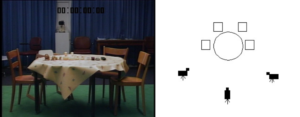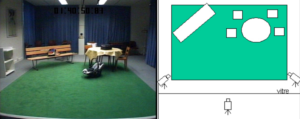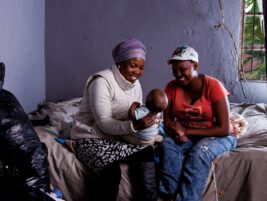Introduction
Mother-baby relationships have been studied in natural conditions (Stern 1974 ; Fogel, 1991), as well as with the help of various observational paradigms such as the « Strange Situation » (Ainsworth, Blehar, Waters et al., 1978) or the «Still face» (Tronick, Als, Adamson et al. 1978; Tronick, 1989). Then, in turn, father-baby interactions have been studied using similar paradigms (Lamb, 1976 ; Parke, 1978 ; Yogman, 1981). The goal of all these observations was to understand the influence of parents on the development of the child and they have allowed us to foreground the links between disturbances in the interactions between parent and child and deviations in the affective and cognitive development of the child (Sameroff & Emde, 1989).
The studies of parent-child pairs have produced much but they cannot isolate the contribution of the family as such. According to the principles of the systemic theory, the family should be considered as a unit in itself, following its own course and having its own particularities. The experience of the child with both its parents cannot be reduced to the sum of its experiences with each parent. When they are both together with her there emerges a new dynamic that gives specific qualities to their interactions. Family functioning should be taken into consideration, when it comes to the understanding of the child’s development (Parke, 1988 ; Hinde & Stevenson-Hinde, 1988; McHale, Kuersten & Lauretti, 1996; Mc Hale & Fivaz-Depeursinge, 1999 ; Cowan & Cowan, 1992 ; Emde, 1991), and, on occasion, the creation of a pathological progression (Bowen, 1972 ; Minuchin, Rosman & Baker, 1978 ; Jacobvitz & al, 2004).
The ‘Lausanne Trilogue Play’ has been perfected to study, as its name suggests, three-way family interactions. In this semi-standardised situation, the parents are invited to play with their child following a four-part scenario. One parent plays with the child watched by the other; then they reverse their roles; all three play together ; finally, it is the child’s turn to be the participant-observer while her parents talk together. This situation allows the observation of coordination and sharing of affects among father, mother and child (Fivaz-Depeursinge, Frascarolo & Corboz-Warnery, 1998; Corboz-Warnery, Fivaz-Depeursinge, Gertsch-Bettens et al., 1993) in all possible permutations of the trio. In addition to the triadic system, several sub-systems may be analyzed: the co-parental couple (the parents in their interactions with the child), the parental sub-systems (the father-child and mother-child dyads) and finally the marital dyad (husband and wife talking in front of the baby). Different versions have been conceived to adapt to the emergence of new abilities in the baby, such as the manipulation of toys and, later, the appearance of language. It is ideal for the study of communication between parents and child (Favez & al., 2006 ; Favez, Abbet & Frascarolo, 2006). One may even study the transition to parenthood as there is also a version of the LTP for use before birth in which the future parents play with a doll representing the expected baby.
However, as its name implies, the LTP is valid only for three people. Since many families include several children, it is important to create appropriate situations that permit continued observation of the family after the birth of younger children, in order to capture the emerging qualities of the family system. Thanks to such situations, we may follow longitudinally, by observing the expansion of the family, not only those systems and sub-systems already mentioned, but also the interactions at the heart of sibling relationships that are important in social development (Tilmans-Ostyn & Meynckens-Fourez, 1999). The Lausanne Family Play (LFP) situation, as well as the Picnic Game (Frascarolo & Favez, 2005), in which the family is invited to play out a picnic, have been designed to satisfy this need. The goal of this article is to present the two situations that allow us, on the one hand, to distinguish functional family interactions from problematic interactions and, on the other hand, to highlight the difficulties and the resources of the observed families. The respective contributions of LFP and PNG will be illustrated by sketches.
Situations of family games
1. The ‘Lausanne Family Play’
The ‘Lausanne Family Play’ (LFP), a situation inspired by the ‘Lausanne Trilogue Play’, (Fivaz-Depeursinge, & Corboz-Warnery, 1999), was conceived to permit the observation, analysis and evaluation of the interactions at the heart of families with more than one child. It is suitable for children from the time when they are able to sit upright in a high chair and up to 12-13 years of age (given that the required activity is a game with toys). The parents and their children are installed in a semi-circle around a circular table. The parents are seated opposite each other on a diagonal and the children are divided between them in a semi-circle. The children’s chairs are suited to their development (high chair, normal chair).

The technical equipment is made up of three cameras ; the first (general view) records the whole family to observe the posture and body orientation of the different family members as well as the distances between them (whether they lean toward each other or not), the second films one parent and half of the children and finally the third films the other parent and the other half of the children. These partial shots, closer up than the general view, allow the rough capture of facial expressions. The three recordings are synchronised and compressed into a single image. The scenario is as follows.
We invite you to play as a family, as you normally do, by following these instructions : in the first part one of the parents plays with the children while the other is simply present; after a while you will reverse the roles, the parent who was simply present will play with the children while the other is simply present. After a moment, you will all play together. Finally, in the fourth and last part, the parents will talk together and the children, for their part, will continue to play. You will decide when to pass from one part to the next. Usually this all takes about a quarter of an hour. You will signal to us when you have finished.
Some toys are provided: a family of lions (the lion, the lioness and as many cubs as there are children in the family, a family of ducks (idem) and as many dummy portable telephones as members of the family.
If the LFP is being used for research purposes, it is recommended to request between one family and the next that the mother and the father begin as the active partner alternatively so as to counterbalance any possible ordering effect. By contrast, if the goal is clinical, the decision as to how they organise themselves is left to the parents.
This game is highly structured; the defined positions of the parents and children (who control the distances between them) as well as the four part scenario impose a strict framework. For parents who are unaccustomed to play as a family and uneasy in symbolic games, to find themselves with the toys and at a distance favourable to visual and expressive exchanges is sometimes stressful. For others, by contrast, thanks to the obligatory framework that structures activities and interactions, this may be reassuring.
A clinical analysis of the whole game may be achieved by concentrating as much on the entire family as on each of the sub-systems that make it up. The family and co-parental alliances are thus priority targets of observation and evaluation. Besides, whereas each of the parts may be analyzed, we may observe in addition the transition from one part to another to see how the parents make decisions and set up the passage from each part to the next.
Coding with the help of an adapted version of the Family Alliance Assessment Scale (FAAS; Lavanchy-Scaiola et al, 2009; Favez, Lavanchy Scaiola, Tissot, Darwiche & Frascarolo, 2010) may be used, particularly in a research context. The tool allows the assessment of the family functioning through the concept of family alliance, defined as the degree of coordination between family members achieving a task (Fivaz-Depeursinge & Corboz-Warnery, 1999). The evaluation is made, then, on the basis of seven scales; 1 – participation (inclusion of partners), 2 – role organization (regard for the scenario and of parents’ roles versus those of children), 3 – focalisation (sharing of a common centre of interest and co-construction of games), 4 – family warmth (sharing of affects), 5 – communication mistakes and their resolution, 6 – co-parental co-ordination and, finally, 7 –child’s involvement.
2. The Picnic Game (JPN) (PNG)
A large carpet (about 4m x 4m) defines the picnic area in which are arranged a table, as many chairs as members of the family, a large and stable bench, a big basket containing a toy teaset and as many toy sacks as there are children (see Figure 2). The parents receive the following instructions: We ask you to play at going on a picnic. Imagine that you arrive with your children in a park. The green carpet defines the area of grass that you may use. Organize yourselves as you wish to prepare the picnic. Then you have the picnic. There are some toys and you may use everything that is available. You are asked to tidy everything away when you are finished. Take your time, usually about a quarter of an hour. Call me when you are finished.

Any family can play the PNG, whatever the number of children and their respective ages. One camera is sufficient for recording it, but several may be used. This situation may be filmed at home but, in that case, standardization may be weaker.
This situation requires of the family a playful and creative attitude, but it also includes some day-to-day tasks like setting the table and tidying toys. The framework provided is extremely flexible. Only the spatial limits are clearly defined. Everything else is in the hands of the family.
The evaluation is carried out in two ways. First in a clinical way by answering the following questions:
1) Participation: are all family members included?
2) Distribution of leadership: do parents frame the interactions or do the children take control? How do the parents share leadership? Do we observe parentification?
3) Structure of the task: are the different parts of the game distinguishable (for example preparing the picnic, setting the table, having the picnic, and so on)? In other words, does the game tell a whole story or is it chaotic? Does the game present originality? Are the family members creative?
4) Fluidity versus rigidity in the management of parents, parent-child(ren) and child(ren) sub-unit(s). Are several configurations observable throughout the game according to different tasks or is one mainly observed? For example, mother taking care of the youngster while father takes care of the older child during the picnic as well as during play or are they all together most of the time, versus several configurations fluently changed according to various tasks?);
5) Co-parenting: do parents work together and support each other in their parental tasks? Or do they work in parallel? Or are competition or hostility observable?
6) Marital relationships. Given the influence of the quality of marital relationships on family interaction, we look for marital couple relationships inside family activities. Do parents share moments of intimacy with positive affects as marital partners besides being parents or, when they speak to each other, is it only in a parental context. Do they directly speak to each other or is it always via the children?
7) Limit setting. Are the parents rather lax, authoritative or authoritarian? Do they set clear limits and make the children respect them?
8) Family warmth. Do family members share positive affects, do they express their affection to each other? Are all members of the family giving and/or receiving positives affects or are some of them rather excluded or cold?
9) Autonomy of the child(ren) sub-system. Are the children constantly under parents attention, of their own will or because the parents tend to control them, or do they have their own space and activities?
Afterwards The Picnic Game may be the object of coding with the help of the RE-PAS, a system of evaluation on several scales by Likert in five points taken from clinical evaluation.
Illustrations, family games
We are now going to give a summary description of two LFPs and two PNGs so as to illustrate the different facets of family interactions as they may be observed with these two tools.
- Lausanne Family Play, functional interactions (father, mother, 6 year old daughter Lara and 13 month old son John)
Having looked at the available toys, the mother proposes telling a story by enacting a role-playing game. She is the director of the zoo, John her assistant and Lara in charge of the lions. She starts the game by telephoning her daughter to order some lions. She integrates the behaviour of the youngest into the game (for example, when he touches the ducks, she says « He’s asking if you have ducks too »). While Lara deals with the lions, the mother explains to the little one what has happened. The daughter then telephones her back to tell that she is there, at the bars with the lions. The mother says she is coming. She greets Lara turns toward John and explains the situation. In this way the mother takes care alternatively of each of them, while keeping the guiding thread of the story and inviting exchanges between them.
After a while, the mother announces a transition by saying that she is calling the lion-tamer and she telephones the father. The father accepts the role given him by the mother and continues the game by proposing to give the lions a bath. Then father and daughter make the lions enter in a truck using the ducks as baits. They deal with the animals then the father announces a transition by proposing to telephone the director. Lara telephones her mother and invites her to come with John.
The mother approves and begins the stage where they all play together. After a moment of sharing over what the father and daughter have done in the preceding stage, there is a moment of hesitation when they don’t know quite what to do. The father asks for help in staging a circus act with the lions. The mother proposes that they jump over the ducks. The three get started and work together to prepare a show. They laugh together over a « failure ». John follows attentively and becomes excited. They reach a moment of affective sharing between the four. Then the mother announces a transition by telling Lara « You are going to play by yourself for a moment ». The father confirms this and adds « You can play with your brother ». The parents give all the toys to the children.
The discussion between the parents starts with difficulty but after a moment they start an exchange about the coming evening. The father proposes finishing the game and, as the mother approves, he calls the consultant.
Analysis : game clearly structured, clear framework given by the parents, the four parts are executed distinctly, integration of the two children, story jointly constructed by the parents and the elder child, the four partners achieve moments of affective sharing.
- Lausanne Family Play, problematic interactions (father, mother, two sons – Jack (eight) and Tom (four)
The father announces that he is starting and asks Jack to name the animals. Tom tries to draw his mother’s attention but she stands still and does not respond. The father quickly runs out of ideas but doesn’t enter into the game proposed by the elder child (to stack up the lions). He tries to telephone Tom who does not reply but tries again to include the mother. The father quickly gives way to the mother with a discouraged tone: « OK then, go ahead ». The mother enters into the game asking the children what they would like to do. Without waiting for their replies, she proposes that they sing. Jack starts but the mother doesn’t listen and plays at telephoning with Tom. Jack starts a fight among the lions who are trying to eat the ducks next to Tom. The children stage a battle between the animals that the mother attempts to calm. The father intervenes to say that the children should play by themselves. Jack recalls the instructions by emphasising that they should now all play together. So, they play with the animals staging battles and rescues. The parents insist on the fact that it is the lion parents who should protect the little ones. After a moment, Jack recalls that the parents should talk together. The parents comply but keep looking at the boys who play, each by himself.
Analysis: The parents have difficulty in setting the framework and respecting the scenario (cf the recall of the instructions by the elder child). Both father and mother have difficulty in initiating games with the children but they manage when they all play together. Co-parenting shows some gaps but is not competitive.
- Picnic Game, functional interactions (father, mother, daughter Sarah (six and a half), son Terry (three and a half).
The parents announce that they are going on a picnic by car. They start off side by side and invite the children to get in the back and all four go forward together. Having arrived, they hold hands to cross the road. The father proposes seeking out a good spot. The mother points out one where there is a bench beside the lake. The father suggests that the mother prepares the picnic while he takes care of the children. The mother prefers leaving them to play by themselves while they prepare the picnic together. The father agrees and they enjoy themselves. The children discover the toys in the bags and from time to time show the parents what they have found. The father asks the children if they would like to go swimming in the lake. Sarah takes off her sandals for swimming, puts on her swimsuit and asks her father for her armbands. He blows them up and puts them on. He does the same for Terry. He tells them to give their mother a kiss before going into the lake, which they do. The mother says she wants them to put on some sun cream, the daughter fetches it and the father reminds them not to forget their noses. Sarah dives into the water. Terry copies her and the father joins in. They swim together and the mother waves to them. When they get out of the water, the father shakes himself dry and gives the children a towel to dry themselves. The mother announces that everything is ready and they can start eating. The children come and sit down around the tablecloth. The father gives everyone something to drink and proposes a toast to the pleasure of being there. The mother says the coffee is very good. The mother serves everyone some chicken, salad and pasta. They wish each other « bon appétit » and then eat. Afterwards the parents say it is time to go home and they all start tidying up. The father concludes by saying that the picnic was delicious and they had a good day.
Analysis: the game, rich in symbols, tells a coherent story. Each member of the family fulfils a role. The parents are coordinated and support each other. There are moments of affect sharing among all of them.
- Picnic, problematic interactions (father, mother, daughter of six, Jennifer, and son of three, Mark)
The father and the children settle down on the carpet and the mother asks if it is wet. The father replies that it is a little damp but alright. The mother gets out Mark’s toys while the father sets the table and Jennifer occupies herself. The father starts to serve food and holds out a plate to his daughter who lets it fall. The father cries out « you’ve dropped everything ». The little one says « no, nothing fell down ». Then she refuses the plate that her father offers her again saying that she doesn’t want any salad. She takes a plate and goes to serve herself something else. The father then offers the plate to the mother. She takes it but makes a disgusted face « it’s a bit wasted, this salad » and there is an exchange of smiles between mother and daughter. The father serves Mark but he doesn’t take the plate and carries on playing. Jennifer takes some coffee and says it is rather strong. The mother says the coffee isn’t for her and tries to take the cup away but the daughter says it is hers and the mother leaves her alone. The mother asks if there is some dessert and the father suggests gathering some strawberries but the mother replies that it is too hot. Jennifer takes her swimming stuff and sets out to swim. When the mother tells her not to put her head under the water, that is what she does. The mother declares that everything needs to be tidied up but Mark refuses to help. The father tells the mother that there is no hurry. When they leave, the mother doesn’t want Jennifer to carry the basket with the dishes but she doesn’t take heed. The mother insists and demands that the father not let her carry it because it is very heavy. The father says « It’s not important » and doesn’t intervene.
Analysis: The game tells a rich, coherent story but the younger child is not always integrated. Several conflicts emerge and a mother-daughter coalition against the father can be seen. Co-parenting is weakly coordinated or even conflicting with uncertain limit setting. There is no sharing of affects among them all.
These four contrasting descriptions show the richness of observation that can be achieved in these semi-standardized and complementary situations concerning the information they provide.
Discussion
Although both situations are play-based, inviting shared pleasure and creativity, they present important differences. The LFP provides a relatively constrained framework : the table and chairs as well as the closely defined positioning of the partners (parents on each side of the children) determine the distances between partners and, partly, their orientation. Again, a scenario defines everyone’s roles (active or third-party observer) and the partners with whom they interact in each part. Only the content of the game is left up to the family’s imagination, even if the toys are imposed. By contrast, in the JPN the framework is much more free since the partners are invited to organize themselves as they wish ; they prepare the picnic they want ; the meal may be taken on the ground, on the bench or at the table, before or after a phase of play with the toys. The partners settle beside whomever they wish and move around as they choose. And so on. Again, the PNG is based on a real life situation but strongly formalized which allows observation of the « habits » of the family (setting the table, tidying, eating etc.)
Remember too that there is no lower age limit for the PNG whereas the LFP requires that the youngest children are able to sit upright (in a high chair). Finally, it is difficult to stage an LFP with more than three children which is not the case with the PNG in which one can even include grandparents or other family members.
Overall therefore, the LFP offers a more rigid framework for interaction than does the PNG. This stricter framework is more suitable for some families than for others and allows us to see how a family may cope with the adaptation to a constrained framework which can be stressful. For some of them, the scenario and the obligatory body position (seated) appears as a limiting obstacle that prevents the game from unfolding. For others, who manage to overcome these limitations, exchanges unfold at verbal and expressive levels and the family members manage to enjoy themselves – which demonstrates good flexibility in a family system that manages to adapt to new situations. However, it should be noted that, on the contrary, some families presenting difficulties in coordinating themselves seem to benefit from the imposed framework as guidance that structures their games. In this case, the situation gives valuable information about the family’s resources and its ability to improve its functioning when the offered context is structured.
With its « pretend » aspect, the PNG is greatly appreciated by certain families who manage to draw back from the context of observation and let themselves play and enjoy themselves together, but less by others who are perhaps more embarrassed to playact or ill at ease with symbolic games.
The perspectives of these two games are also quite different. Given that, in the PNG the families have freedom of movement and positioning, the images are more generic and close-ups unreliable. On the contrary, in the LFP closer views may allow coding of gaze and emotion more easily.
During video feedback the respective content of the LFP and PNG facilitate the start of discussion of different subjects ; with the openness of daily life (task sharing, meal-time rituals, limit-setting for children etc.) offered by the PNG and the window on symbolic games and the capacity to share pleasure given by the LFP.
These particularities, specific to the two games, emphasize that they are complementary and offer a sound basis for using them together as much for clinical as for research evaluation.
References
Ainsworth, M. D. S., Blehar, M. C., Waters, E., & Walls, S. (1978). Patterns of attachement : A psychological study of the strange situation. Hillsdale, NJ : Erlbaum.
Bowen, M. (1972). Toward the differentiation of self in one’s own family. In: L. Framo (Ed.), Family Interaction: A dialogue between family researchers and family therapists (pp. 11-173). New York : Springer.
Corboz-Warnery, C., Fivaz-Depeursinge, E. Gertsch-Bettens, A., & Favez, N. (1993). Systemic analysis of father-mother-baby interaction : The Lausanne Triadic Play. Infant Mental Health Journal, 14, 298-316.
Cowan, C. P., & Cowan, P. A. (1992). When partners become parents. The big life change for couples. New York : Basic Books.
Emde, R. N. (1991). The wonder of our complex enterprise: Steps enabled by attachment and the effects of relationships on relationships. Infant Mental Health Journal, 12, 164-173.
Favez, N., Abbet, E., & Frascarolo, F. (2006). Preschoolers’ family narratives of an emotional event : Interactive precursors during infancy and toddlerhood. In N. Favez (Chair), (2006). From pregnancy to school: Narratives as an index of family functioning and child social development. Présentation orale en symposium, 10ème Congrès de la WAIMH, Paris, France, 10 juillet.
Favez, N., Frascarolo, F., Carneiro, C., Montfort, V., Corboz-Warnery, A., & Fivaz-Depeursinge, E. (2006). The development of the family alliance from pregnancy to toddlerhood and children outcomes at 18 months. Infant and Child Development, 15, 59-73.
Fivaz-Depeursinge, E., & Corboz-Warnery, A. (1999). The primary triangle. A developmental systems view of mothers, fathers, and infants. New York : Basic Books.
Fivaz-Depeursinge, E. Frascarolo, F., & Corboz-Warnery, A. (1998). Evaluation de l’alliance triadique dans un jeu père-mère-bébé. Devenir, 10, 79-104.
Fogel, A. (1991). Infancy : infant, family, and society. St Paul, MN, US : West Publishing Co.
Frascarolo, F., & Favez, N. (2005). Une nouvelle situation pour évaluer le fonctionnement familial: le Jeu du Pique-Nique. Devenir, 17, 141-151.
Hinde, R. A., & Stevenson-Hinde, J. (1988). Interpersonal relationships and child development. In : S. Chess, A. Thomas, & M. Hertzig (Eds). Annual progress in child development (pp. 5-25). New York : Brunner & Mazel.
Jacobvitz, D., Hazen, N., Curren, M., & Hitchens, K. (2004). Observations of early triadic family interactions: Boundary disturbances in the family predict symptoms of depression, anxiety, and attention-deficit/hyperactivity disorder in middle childhood. Development and Psychopathology, 16, 577-592.
Lamb, M.E. (1976). The Role of the Father in Child Development. New-York : Wiley.
Lavanchy Scaiola, C., Favez, N., Tissot, H., & Frascarolo, F. (2009). The Family Alliance Assessment Scales (FAAS), manuel de codage. Manuel non publié. Manuel non publié.
McHale, J., & Fivaz-Depeursinge, E. (1999). Understanding triadic and family group interactions during infancy and toddlerhood, Clinical Child and Family Psychology Review, 2, p. 107-127.
McHale, J., Kuersten-Hogan, R., & Lauretti, A. (1996). New directions in the study of family-level dynamics during infancy and early childhood. In J. McHale, & P. Cowan (Eds). Understanding how family-level affects children’s development : study of two-parents family (pp. 6-44). San Francisco : Jossey-Bass.
Minuchin, S., Rosman, L., & Baker, B.L. (1978). Psychosomatic Families. Cambridge : Harvard University Press.
Parke, R.D. (1978). The Father’s Role in Infancy: A Re-evaluation. Birth and the Family Journal, 5, 211-213.
Sameroff, A. J. & Emde, R. N. (1989). Relationship disturbances in early childhood. New York : Basic Books.
Stern, D. N. (1974). Mother and infant at play: The dyadic interaction involving facial, vocal and gaze behaviors. In : M. Lewis, & L. Rosenblum (Eds). The origins of behavior, I. The effect of the infant on its caregiver (pp. 187-213). New York : Wiley and sons.
Tilmans-Ostyn, E., & Meynckens-Fourez, M. (1999). Les ressources de la fratrie. Sainte-Agne : Eres Ramonville.
Tronick, E. Z. (1989). Emotions and emotional communications in infants. American Psychologist, 44, 112-119.
Tronick, E., Als, H. Adamson, L. Wise, S., & Brazelton, T. B. (1978). The infant’s response to entrapment between contradictory messages in face-to-face interaction. Journal of the American Academy of Child Psychiatry, 17, 1-13.
Yogman, M.W. (1981). Games Fathers and Mothers Play with Their Infants. Infant Mental Health Journal, 2, 241-248.
Observational situations of interactions in families of four and more people
Authors
Frascarolo, France,
Tissot, Herve,
Favez, Nicolas,
France








